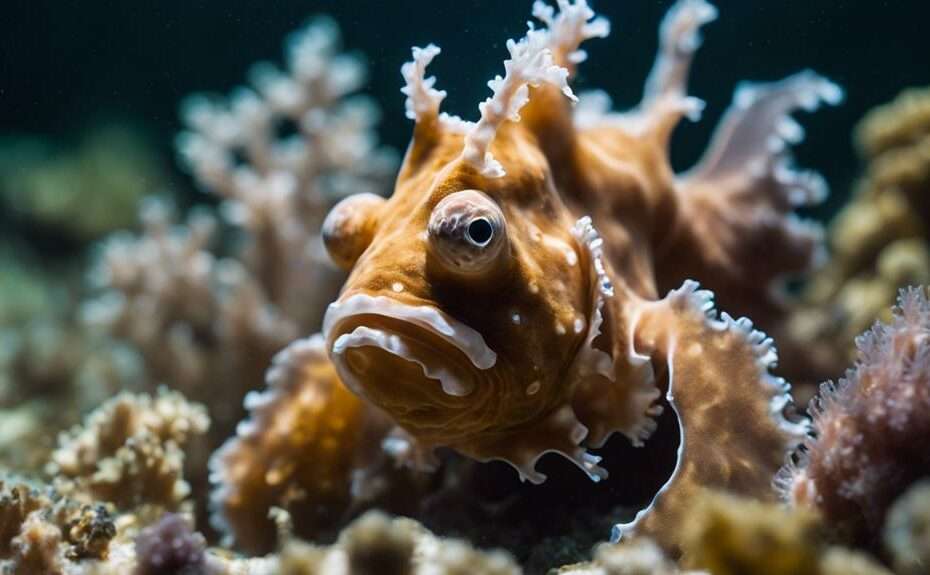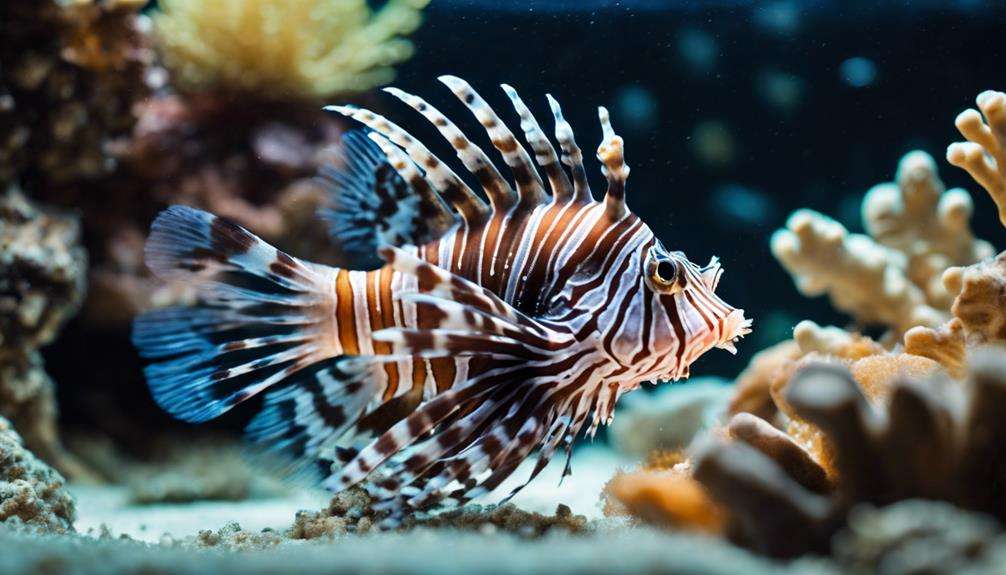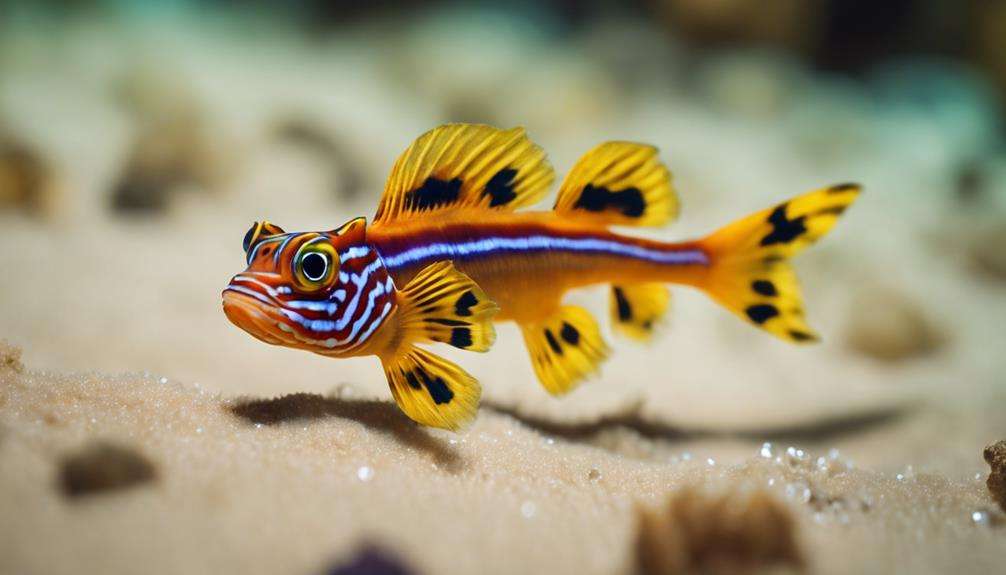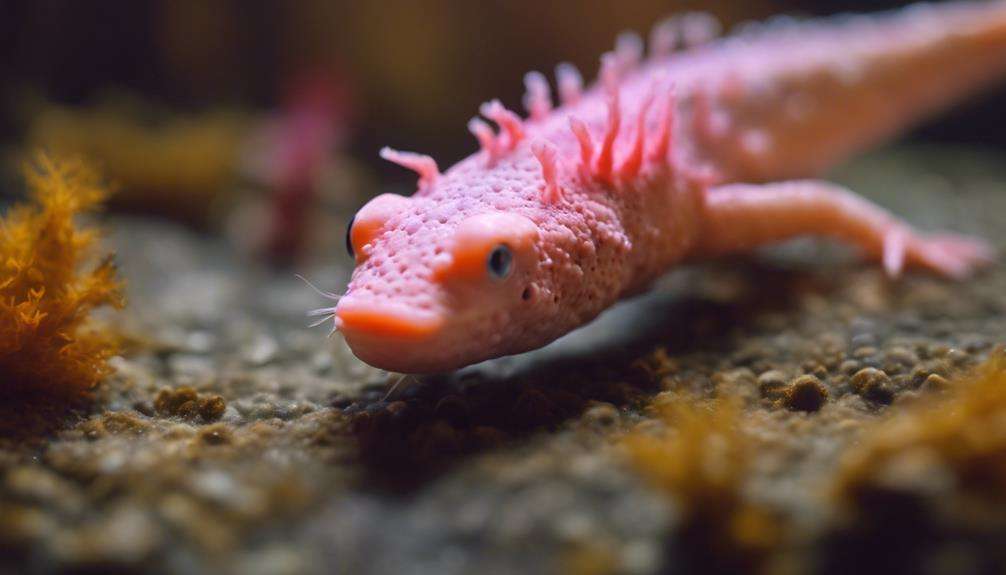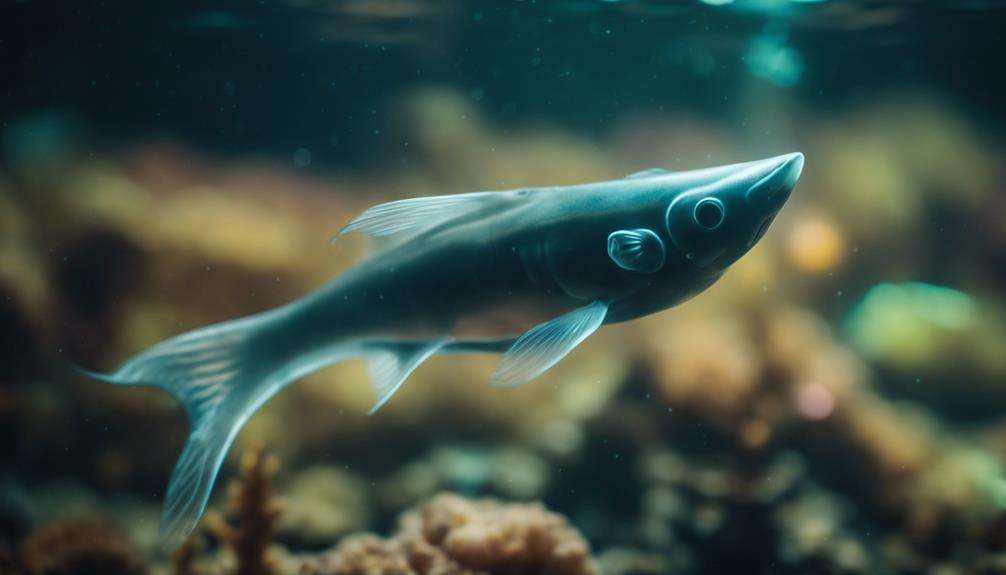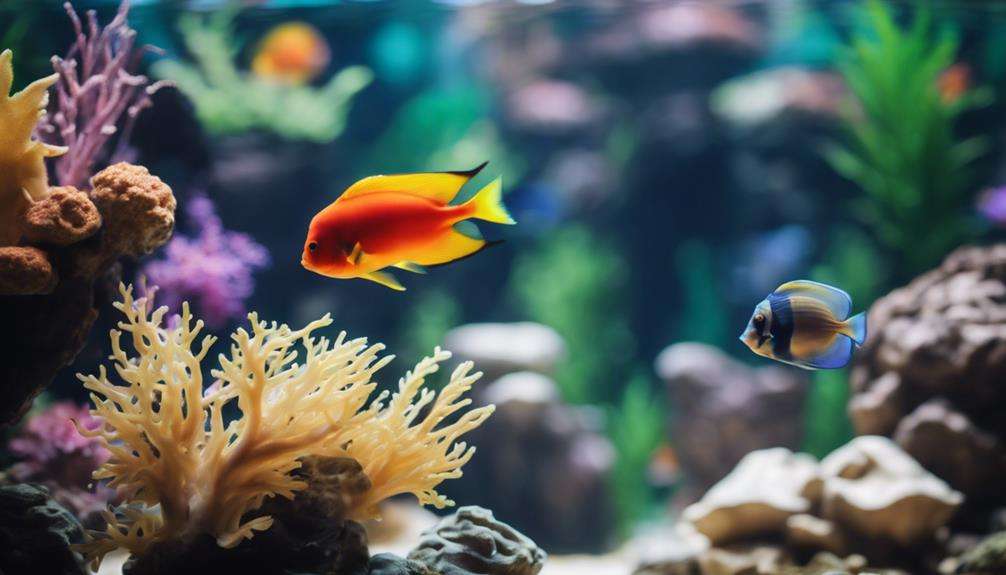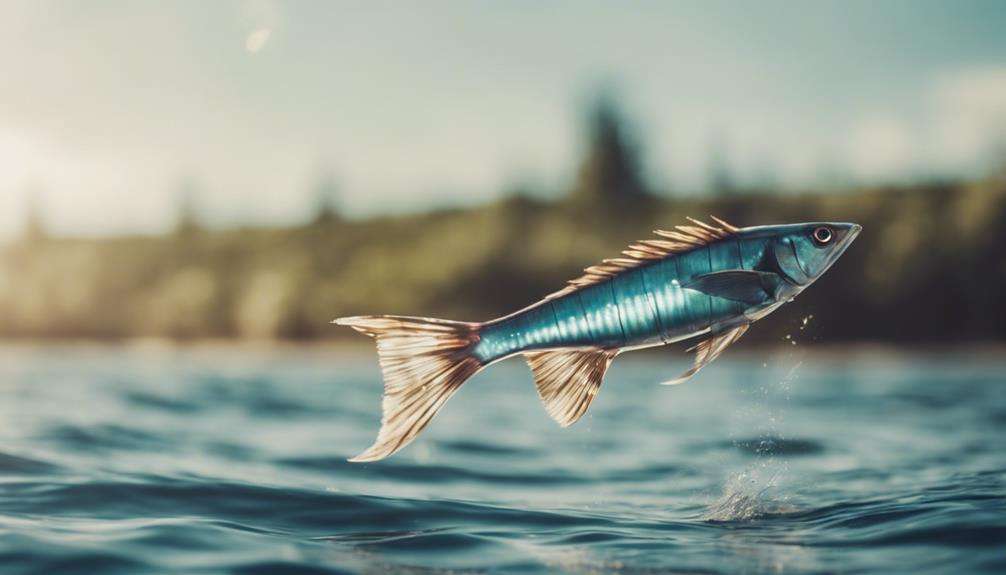In the vast ocean, where camouflage is key to survival, frogfish stand out by blending in with their surroundings like masterful artists.
But there's more to these peculiar creatures than meets the eye.
As you explore the depths of their world, you'll uncover a tapestry of unique features that will challenge your understanding of marine life.
Key Takeaways
- Frogfish utilize camouflage abilities for effective hunting and defense strategies.
- Their hunting techniques involve using a retractable lure to attract and capture prey.
- Jet propulsion enhances their speed and precision in ambushing prey underwater.
- Unique reproductive strategies include male frogfish undergoing parasitic transformation for successful breeding.
Unique Frogfish Camouflage Abilities
Among the fascinating features of frogfish, their ability to change skin color, texture, and size stands out as a remarkable example of masterful camouflage in the underwater world. These masters of disguise can alter their appearance to blend seamlessly with their surroundings, whether it be mimicking the colors of coral reefs, sandy bottoms, or rocky outcrops.
By adjusting their skin coloration, which ranges from vibrant hues to muted tones, frogfish can remain virtually invisible to unsuspecting prey and potential predators alike. Moreover, their ability to modify the texture of their skin allows them to mimic the roughness of algae-covered rocks or the smoothness of soft corals, further enhancing their camouflage prowess.
In terms of size, frogfish can adjust their body proportions to match the environment they inhabit, ensuring that they remain inconspicuous while patiently waiting for their next meal to swim by. This remarkable capability to blend with their surroundings showcases the evolutionary adaptation that has made frogfish highly successful ambush predators in the depths of the ocean.
Quirky Frogfish Hunting Techniques
The remarkable frogfish, known for their masterful camouflage abilities, employ unique hunting techniques that showcase their unparalleled predatory skills. These quirky hunters use a retractable lure called an esca, positioned above their mouth, to attract prey. The esca is a versatile tool that can imitate various marine creatures like worms, shrimp, or squid, effectively luring unsuspecting prey. Frogfish excel at aggressive mimicry, using their esca to deceive prey into approaching within striking range for a swift ambush.
Their hunting behavior is characterized by lightning-fast prey engulfment, with the fastest recorded at an astonishing 6 milliseconds. This rapid capture demonstrates the frogfish's exceptional speed and precision in securing meals. Furthermore, specialized muscles in their mouths prevent captured prey from escaping, ensuring successful hunts for these unique marine predators.
With their deceptive tactics and efficient hunting skills, frogfish are truly fascinating creatures to observe in their natural habitat.
Jet Propulsion in Frogfish
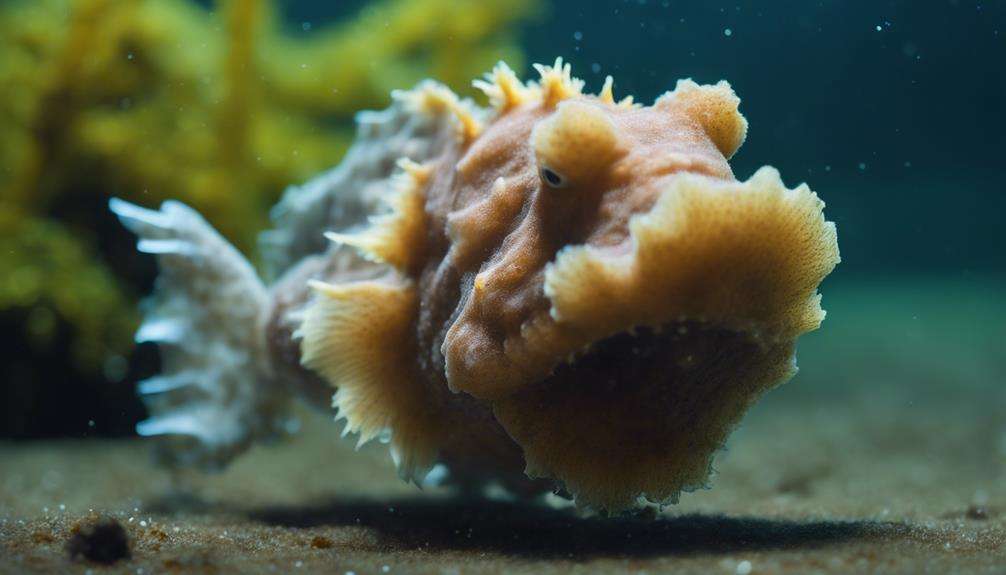
Employing a sophisticated mechanism known as jet propulsion, frogfish propel themselves with precision to swiftly ambush their unsuspecting prey underwater. This unique ability enables frogfish to achieve sudden bursts of speed, aiding them in capturing prey effectively in their underwater environment.
By expelling water from their gill openings, frogfish can control the direction and force of their jet propulsion, propelling them towards their target with remarkable accuracy. Jet propulsion serves as a crucial tool for frogfish, allowing them to surprise and engulf prey in a swift and efficient manner.
The ability to navigate using jet propulsion gives frogfish a strategic advantage in hunting, making them formidable predators in the depths of the ocean.
- Frogfish use jet propulsion to move quickly and ambush prey.
- This mechanism allows for sudden bursts of speed in the underwater environment.
- Jet propulsion aids in capturing prey by propelling frogfish towards their target with precision.
Frogfish Feeding Habits Unveiled
As you observe the intricate feeding habits of frogfish, you'll notice their specialized prey capture techniques.
Their unique feeding mechanisms, such as using a lure to attract prey, set them apart in the underwater world.
The ability to rapidly expand their mouths up to 12 times their size allows frogfish to engulf prey swiftly and efficiently.
Feeding Mechanisms Explained
Utilizing a mesmerizing lure to attract prey, frogfish exhibit a feeding mechanism that mirrors the strategic approach of anglerfish. Their flexible stomachs enable them to consume prey twice their size, showcasing impressive feeding capabilities. Frogfish can expand their mouths up to 12 times their resting size to engulf prey swiftly and efficiently.
The rapid feeding behavior of frogfish is exemplified by the fastest prey engulfment recorded in just 6 milliseconds. After feeding, water exits through their gill openings, sometimes revealing prey movements within their stomach, providing insight into their digestive processes.
- Frogfish use a lure to attract prey, similar to anglerfish.
- Their flexible stomachs allow them to swallow prey twice their size.
- Frogfish can swiftly engulf prey by expanding their mouths up to 12 times their resting size.
Unique Prey Capture Techniques
With its illicium lure poised above its mouth, the frogfish expertly mimics potential food items to attract unsuspecting prey, showcasing its unique prey capture techniques. Frogfish have remarkable prey capture abilities, utilizing their specialized mouth structure to engulf prey rapidly.
The illicium lure, an example of aggressive mimicry, deceives unsuspecting prey like worms, shrimp, or squid into approaching. Once the prey is within reach, the frogfish can expand its mouth up to 12 times its resting size, allowing for the swift swallowing of the captured prey whole.
To ensure successful feeding, frogfish possess a specialized muscle that prevents prey from escaping once engulfed. In fact, the fastest prey engulfment on record for frogfish is an impressive 6 milliseconds, highlighting their efficient hunting skills.
Intriguing Frogfish Reproduction Methods
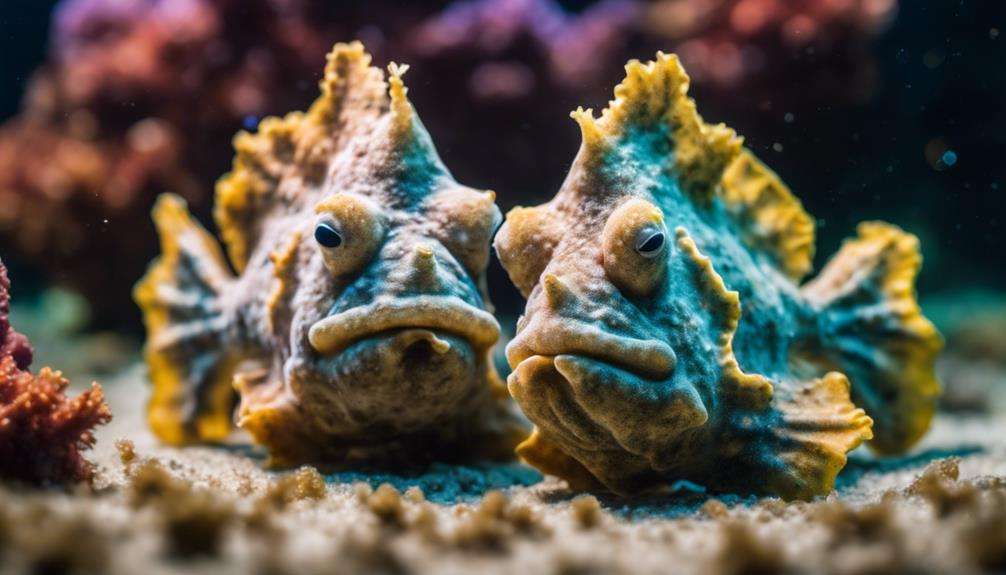
During the intriguing process of frogfish reproduction, female frogfish can lay thousands of buoyant eggs which are later fertilized externally by the males before floating in the water until hatching. This method of reproduction in frogfish is fascinating and essential for the continuation of their species.
Here are some key points to consider:
- Buoyant Eggs: Female frogfish release numerous buoyant eggs into the water column, increasing the chances of fertilization and survival.
- External Fertilization: Males fertilize the eggs externally, a unique method that allows for genetic diversity and ensures successful fertilization in the aquatic environment.
- Low Survival Rates: Despite the large number of eggs produced, survival rates for frogfish larvae are relatively low due to various predation risks, emphasizing the challenges these tiny creatures face during their early stages of life.
Understanding these reproduction methods sheds light on the intricate and delicate balance necessary for the survival of frogfish populations in their marine habitats.
Unconventional Swimming Behavior of Frogfish
In the realm of underwater locomotion, the frogfish captivates observers with its unconventional and mesmerizing swimming behavior. It showcases a fusion of jumping, walking, and jet propulsion techniques that set it apart from conventional fish species. Unlike most fish, frogfish lack a swim bladder, but they compensate for this limitation with their unique swimming style. They employ jet propulsion for quick bursts of movement, aiding in efficient prey ambushes.
What truly distinguishes frogfish is their ability to walk on the sea floor using modified pectoral fins as leg-like appendages, a feature not commonly seen in other aquatic creatures. This unconventional swimming behavior allows frogfish to navigate their environment with remarkable agility and precision. By combining elements of walking, jumping, and jet propulsion, frogfish have evolved a truly distinctive method of underwater locomotion that showcases their remarkable adaptability and efficiency in the marine world.
Rare Psychedelic Frogfish Species
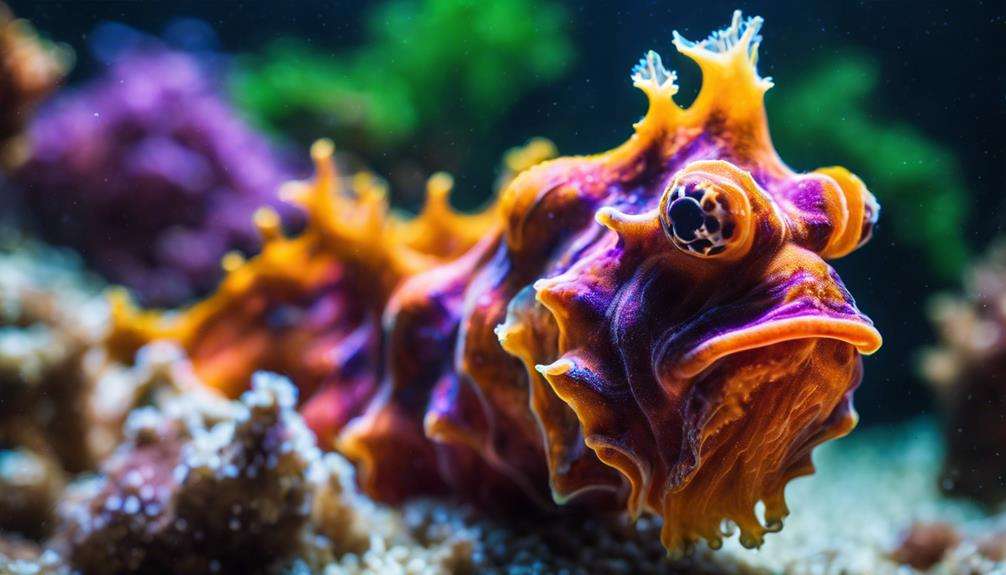
A vibrant and visually striking discovery in the waters of Ambon, Indonesia in 2009 was the rare psychedelic frogfish species, Histiophryne psychedelica. This unique frogfish species showcases a vibrant coloration pattern resembling a psychedelic design, making it truly eye-catching. Histiophryne psychedelica exhibits unusual behaviors, such as 'walking' on its pectoral fins, adding to its distinctiveness.
The rare psychedelic frogfish, Histiophryne psychedelica, boasts a vibrant and psychedelic coloration pattern that sets it apart from other species. This fascinating frogfish species showcases a peculiar behavior of 'walking' on its pectoral fins, a unique trait not commonly observed in marine life. Histiophryne psychedelica's camouflage abilities are exceptional, allowing it to seamlessly blend into its coral reef habitat, aiding in its hunting strategies.
Researchers are diligently studying and monitoring the population of the rare psychedelic frogfish to gain deeper insights into its ecology and conservation requirements.
Mimicry in Juvenile Painted Frogfish
Mimicry in juvenile painted frogfish intricately mirrors their coral surroundings, showcasing remarkable adaptation and camouflage skills. These young frogfish possess a remarkable ability to blend seamlessly into the vibrant and intricate coral reef ecosystem. Their coloration and patterns mimic the coral structures with such precision that they become nearly indistinguishable from their environment. This camouflage isn't merely for aesthetic purposes; it's a crucial survival strategy that aids in evading predators and ambushing prey effectively.
The mimicry displayed by juvenile painted frogfish isn't static but dynamic, adapting to different coral structures as they move through their habitat. This behavior allows them to remain hidden from both predators and unsuspecting prey, enhancing their hunting success. By seamlessly integrating into the coral reef environment, these young frogfish demonstrate their exceptional adaptation to their surroundings. This mimicry showcases the incredible camouflage skills possessed by juvenile painted frogfish, highlighting their mastery of blending in with their coral homes.
Egg-Laying Patterns of Frogfish
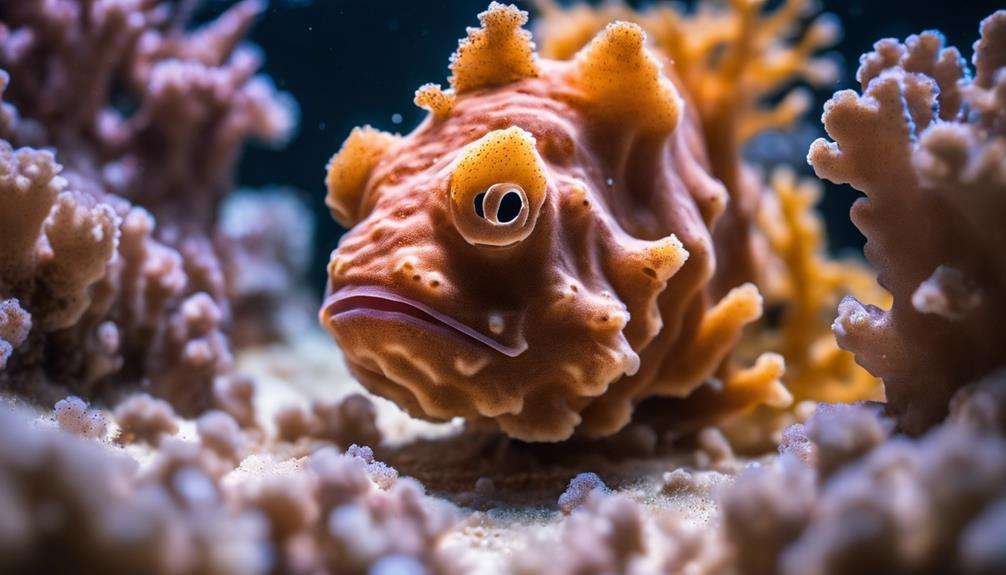
Demonstrating a pivotal aspect of their reproductive strategy, female frogfish exhibit a remarkable ability to lay thousands of buoyant eggs at a time, contributing significantly to the population dynamics of marine environments. These eggs, ranging from 40,000 to 180,000 per spawning event, play a crucial role in the survival and propagation of frogfish populations. The egg-laying patterns of frogfish are intricately linked to their reproductive strategy, ensuring the continuation of their species in diverse marine ecosystems.
- Female frogfish release thousands of buoyant eggs during spawning events, providing a substantial opportunity for fertilization and subsequent development.
- The buoyant nature of the eggs allows them to float in the water column, increasing the chances of dispersal and reducing the risk of predation in the early stages of life.
- The massive number of eggs laid by female frogfish enhances the species' ability to adapt to varying environmental conditions and maintain stable population sizes over time.
Understanding the egg-laying patterns of frogfish is vital for comprehending their reproductive success and the conservation efforts required to safeguard these unique marine creatures.
Male Frogfish Parasitic Transformation
Male frogfish undergo a remarkable parasitic transformation, attaching to the female's body and merging with her tissue, ultimately losing most internal organs and relying on the female for sustenance. This behavior, known as sexual parasitism, is a crucial aspect of the reproductive strategy of certain frogfish species.
The male's physiological changes are essential for successful fertilization and reproduction. By becoming dependent on the female for nutrients, the male ensures that its body can focus on producing sperm, thus increasing the chances of fertilizing the female's eggs.
This parasitic adaptation in male frogfish exemplifies an intriguing evolutionary strategy where the male sacrifices its autonomy to enhance the reproductive success of the species. Through this process, male frogfish showcase a unique and specialized way of ensuring the continuation of their genetic lineage, highlighting the fascinating intricacies of reproductive strategies in the animal kingdom.
Frequently Asked Questions
What Is Unique About a Frogfish?
You'll be amazed by a frogfish's uniqueness. Their camouflage techniques, unusual adaptations, predatory behavior, mimicry strategies, and hunting tactics make them extraordinary. They change color like chameleons, use a lure to attract prey, and walk on fins!
What Is the Appearance of Frogfish?
When you look at a frogfish, you'll notice its colorful camouflage, bulbous body, textured skin, wide mouth, and unique lure fishing technique. These features help it blend in seamlessly with its surroundings for successful hunting.
What Type of Camouflage Do Frogfish Have?
Frogfish utilize remarkable mimicry techniques, swiftly changing color and texture to match diverse backgrounds. Their adaptive patterns and disguise mechanisms create effective camouflage strategies, making them blend seamlessly with surroundings to ambush prey and evade predators.
What Are the Characteristics of the Giant Frogfish?
At up to 30 inches long, the giant frogfish showcases remarkable size variations. They excel at ambush predation, using their unique lure and camouflage. Reproduction in these masters of disguise involves external fertilization, while their skin projections aid in environmental adaptation.
Conclusion
As you reflect on the peculiarities of frogfish, you can't help but marvel at their sheer adaptability and ingenuity in the vast oceanic realm.
These quirky creatures, with their mesmerizing camouflage abilities and unconventional hunting techniques, truly stand out as evolutionary marvels.
So next time you encounter a frogfish in the depths of the sea, remember that their unique features and behaviors are a testament to the wonders of nature's time machine.
